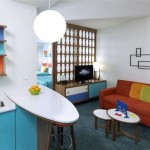Colors for Interior Design: A Guide to Choosing the Right Hues
Choosing the right colors for your interior design can significantly impact the overall feel and ambiance of your space. From creating a calming and serene atmosphere to stimulating creativity and energy, colors play a crucial role in shaping how we experience our homes. This guide explores key considerations for selecting interior colors, focusing on the psychology of color and practical tips for achieving harmonious and visually appealing spaces.
Understanding the Psychology of Color
Color psychology delves into the emotional and psychological effects of different colors. Understanding these associations can guide your choices, creating spaces that align with your desired mood and purpose. For instance:
- Warm Colors (Reds, Oranges, Yellows): Associated with energy, excitement, and enthusiasm, they can stimulate appetite and conversation. They are often used in dining rooms or living areas where social interaction is encouraged.
- Cool Colors (Blues, Greens, Purples): These colors evoke feelings of calm, serenity, and tranquility. They are often used in bedrooms or bathrooms for a sense of relaxation and peace.
- Neutral Colors (Whites, Grays, Blacks): These colors create a sense of balance and provide a clean, modern backdrop for other colors and furnishings.
It's important to note that color preferences are subjective, and cultural influences can also play a role in how colors are perceived.
Choosing the Right Color Palette
Once you understand the psychological effects of different colors, you can start building a color palette that suits your needs and preferences. Here are some key considerations:
1. Light and Space:
Consider the amount of natural light that enters the room. Darker colors absorb light, making small spaces feel even smaller. Conversely, lighter colors reflect light, making rooms feel larger and brighter. In rooms with limited natural light, using lighter colors can create a more spacious and welcoming ambiance.
2. Color Harmony and Contrasts:
Color harmony refers to using colors that complement each other, creating a visually pleasing and balanced effect. Analogous colors are found next to each other on the color wheel, while complementary colours are opposite each other. Using a combination of analogous and complementary colours can create a visually stimulating and dynamic space.
3. Personal Preferences and Lifestyle:
Ultimately, the best colors for your home are those that you find appealing and reflect your personal style and lifestyle. Consider your preferred color combinations, textures, and materials. For example, if you enjoy spending time in nature, incorporating earthy tones or nature-inspired patterns might be suitable. If you prefer a minimalist aesthetic, neutral colors with clean lines might be a better choice.
Practical Tips for Using Colors Effectively
Here are some practical tips for incorporating colors into your interior design effectively:
1. Start with a Neutral Base:
A neutral color palette provides a versatile backdrop for adding pops of color through furniture, rugs, and accessories. Using neutral colors for walls and larger furniture pieces allows for flexibility and allows you to easily change your decor without a complete overhaul.
2. Use Color Accents Sparingly:
Introduce bolder colors strategically to create visual interest and focal points. Accent walls, decorative items, or colorful throw pillows can add a touch of personality and energy to your space. Using color sparingly can ensure that the space doesn't feel overwhelming or chaotic.
3. Consider the Room's Function:
Think about the intended use of the room when choosing colors. For example, calming colors like blues and greens might be suitable for bedrooms or bathrooms, while stimulating colors like reds and oranges might be appropriate for kitchens or dining rooms.
4. Sample Colors Before Committing:
Before painting walls or making significant color decisions, test paint swatches on the walls in natural light. This allows you to see how the colors look in the room at different times of day and helps you choose the right shade.
Choosing the right interior colors can significantly impact the overall mood and ambiance of your space. By understanding the psychology of color, considering the room's function and personal preferences, and applying practical tips for using color effectively, you can create a visually appealing and harmonious home that reflects your unique style and personality.

Colores Fríos Para Decorar Interiores Inspiración 2024 Salas Modernas Decoración De Unas Pintar Casas

Claves Para Elegir El Color De Las Paredes En 2024 Racc Nexdom

30 Colores Con Los Que Pintar Las Paredes De Tu Casa

Combinación De Colores Para Una Casa Más Elegante Foto 1

Colores De Pintura Para Interiores Guía Transformar Tu Hogar

Pinturas Para Interiores De Casas

Colores Tendencia Para Interiores Primavera Verano 2024 2010 Eurocyd

Colores En Interiores Cómo Usar Y Elegir Para

Tendencias De Colores Para La Decoración Interiores En 2024

Qué Colores Aplicar Para Los Interiores De Casas Modernas Prisa








